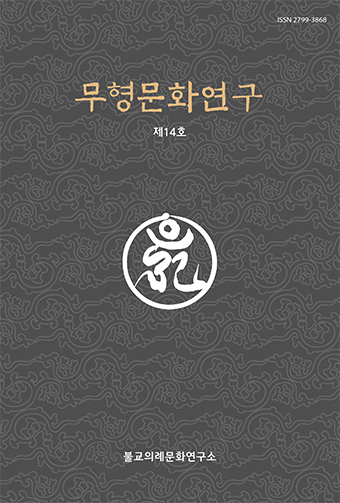일반논문
Abstract
References
Information
초기 경전에 나타난 출가자 수행은 계ㆍ정ㆍ혜로 요약할 수 있다. 그러나 재가자는 출가자와 같이 많은 계율을 지니거나 선정 수행에 몰두하기 어려워 오계와 같은 간단한 계율을 지키면서 수행에서는 보시가 중요한 역할을 한다.
보시는 사무량심 수행과 밀접한 관련이 있는데, 사무량심은 번뇌를 대치하는 데 효과적이며 해탈도(解脫道) 수행이 되기도 한다. 먼저 보시는 자비심에서 비롯하며, 보시하여 기뻐하는 마음을 내면, 곧 즐거움이 있어서 뜻이 견고해지며 문득 즐거움과 괴로움이 있음을 알고서 돌이켜 뉘우쳐서 여실하게 고집멸도가 있음을 알게 되는 공덕이 따른다고 하였다. 그리고 보시는 평등하게 실천하여야 하는데, 평등한 마음으로 보시해야 한다는 것은 보시하는 사람의 세속적 애증과 원친에 따라서 보시하려는 마음을 제어하고 차별 없는 마음을 가지고 보시해야 한다는 의미가 된다. 보시하면서 자비심을 닦고, 환희심을 일으키고, 평등한 마음을 닦는다면, 보시의 실천이 곧 자비희사의 사무량심 수행과 관련된다. 그리고, 붓다의 깨달음 과정을 보면 자비심은 사선정을 통하여 완전한 해탈과 열반에 도달하기 위한 전제조건이 된다. 그러므로 진정한 보시를 실천하면서 자비희사의 사무량심을 닦는 건 해탈과 열반에 도달하기 위한 조건을 갖추는 수행이 된다. 나아가 재가자가 바른 경제생활로 재화를 축적하여 생활하면서 보시를 통한 사무량심을 수행한다면 해탈과 열반을 지향한다고 할 수 있다.
In the Early Buddhist scriptures, there is a difference in the practices of the monks and the layperson, and the monks practiced precepts, meditation, and wisdom as the basis for the practice, but the Dāna is important for the layperson. Dāna is a practice of building merit, but it also has the meaning of practice, and in this article, the relationship between the practice of the four immeasurable minds and Dāna is reviewed. Dāna is deeply related to the four immeasurable minds, that is, Maitri and Karuna and Mudita and Upekkha. The practice of the four immeasurable minds is more meritorious than any other donation or the devotion of the precepts. Even for a moment, the merit of cultivating Maitri is very great, and it is said that the merit of practice of completing wisdom is greater than the merit of cultivating Maitri. The four immeasurable minds is a practice that both a layman and a Buddhist monk can practice, but the process of the Buddha's Enlightment makes it a prerequisite for complete liberation and nirvana through the four stages of dhyana.
On the other hand, there is a view that complete liberation and nirvana are possible only by carrying out the four immeasurable minds, but if you look at the process of the Buddha's Enlightment, it can be said that the four immeasurable minds is an essential requirement in the process of reaching complete liberation and nirvana through the four stages of dhyana rather than practitioner of Buddha-dharma could be reaching complete liberation and nirvana through the four immeasurable minds only. Therefore, in the case of the Buddha, it cannot be said that complete liberation and nirvana are possible only by the four immeasurable minds. However, since the sincere Dāna of the layman enables the performance of the four immeasurable minds, the sincere Dāna of the layman can be a practice that meets the important requirements to reach complete liberation and nirvana. Therefore, a layman can live by accumulating goods with a good economic life, while pursuing liberation and nirvana through the four immeasurable minds with Dāna.
- TD: 大正新脩大藏經.
- 『長阿含經』(TD 1).
- 『中阿含經』(TD 1).
- 『増一阿含經』(TD 2).
- 『過去現在因果經』(TD 3).
- 『優婆塞戒經』(TD 24).
- 각묵 스님(2006). 『디가 니까야』, 제1권. 울산: 초기불전연구원.
- 각묵 스님(2009a). 『상윳따 니까야』, 제1권. 울산: 초기불전연구원.
- 각묵 스님(2009b). 『상윳따 니까야』, 제2권. 울산: 초기불전연구원.
- 대림 스님(2012a). 『맛지마 니까야』, 제2권. 울산: 초기불전연구원.
- 대림 스님(2012b). 『맛지마 니까야』, 제4권. 울산: 초기불전연구원.
- 전재성 역주(2009). 『맛지마 니까야』. 서울: 한국빠알리성전협회.
- 각묵 스님(2010). 『초기불교이해』, 울산: 초기불교연구원.
- 강기선(2020). 「아함경에 내재된 보시사상 연구-한역 4아함을 중심으로-」, 『보조사상』, 제57호. 서울: 보조사상연구원.
- 강명희(2020). 「초기불교에 나타난 4무량심설의 유형별 분석-아함경 중심으로-」, 『불교학보』, 제90권. 서울: 동국대학교 불교문화연구원.
- 김준호(2008). 「초기불교 禪定說의 체계에 관한 연구」, 부산: 부산대학교박사학위논문.
- 김형준(2000). 「原始禪의 本質 및 그 修習構造에 관한 一考」, 『불교학연구』. 서울: 불교학연구회.
- 박경준(2022). 『불교사회경제사상』. 서울: 운주사.
- 박소령(2014). 「大乘佛敎 在家佛子의 信行과 位相 연구」. 서울: 동국대학교박사학위논문.
- 박재은(2016). 「불교 수행에 있어서 우뻬카(Upekkhā)에 관한 연구 : 초기ㆍ상좌부 불교를 중심으로」. 서울: 서울불교대학원대학교 박사학위 논문.
- 윤희조(2022). 「사무량심에 대한 두 가지 해석과 심리치료적 함의」, 『동아시아불교문화』, 제51권. 부산: 동아시아불교문화학회.
- 이은경ㆍ안양규(2023). 「재물(財物)에 대한 탐욕(貪欲)과 그 해결 - 4부 니까야(Nikāya)를 중심으로 -」, 『동아시아불교문화』, 제56권. 부산: 동아시아불교문화학회.
- 이필원(2010). 「四無量心의 ‘解脫道’적 성격 고찰」, 『불교연구』. 서울: 한국불교연구원.
- 이혜옥(2006). 「4무량심(四無量心)에 대한 고찰」, 『한국선학』, 제15권. 서울: 한국선학회.
- 임승택(2008). 「初期經典에 나타나는 궁극 목표에 관한 고찰」, 『불교학연구』. 서울: 불교학연구회.
- 장성우(2020). 「공덕수행으로서의 보시와 그 현대적 의미」, 『불교평론』. 서울: 불교평론사.
- 추인혜(2019). 「초기불교의 관점에서 본 소유와 괴로움」, 『순천향 인문과학논총』. 아산: 순천향대학교 인문학연구소.
- 황이선(1963). 「在家佛敎에 關한 硏究」. 서울: 동국대학교 석사학위 논문.
- 平川 彰(1963). 「出家者の財施」, 『印度學佛教學研究』, 11巻 2号. 東京: 日本印度學佛敎學會.
- Cho, M.L. (2010). “The Concept of Donation : A Comparison between the Vedic and the Buddhist Traditions”, 大覺思想. Vol. 14. 서울: 대각사상연구원.
- Vetter, T. (1988). The ideas and meditative practices of early Buddhism, Leiden, New York: E.J. Brill.
- 불교기록문화유산아카이브, http://dongguk.vacusoft.co.kr/index. 2023.12.16 검색.
- Baidu백과, https://baike.baidu.hk/item/%E8%AE%8A%E6%82%94/9507974. 2023. 12.16. 검색.
• 약호 및 원전류
• 단행본 및 논문류
• 기타
- Publisher :불교의례문화연구소
- Publisher(Ko) :불교의례문화연구소
- Journal Title :Intangible Culture
- Journal Title(Ko) :무형문화연구
- Volume : 11
- Pages :57~75
- DOI :https://doi.org/10.23058/IC.11..202312.57


 Intangible Culture
Intangible Culture





